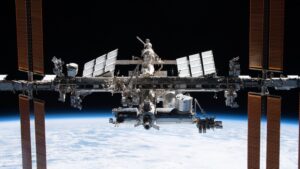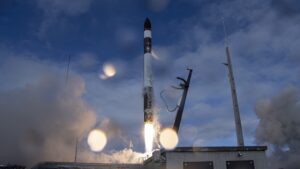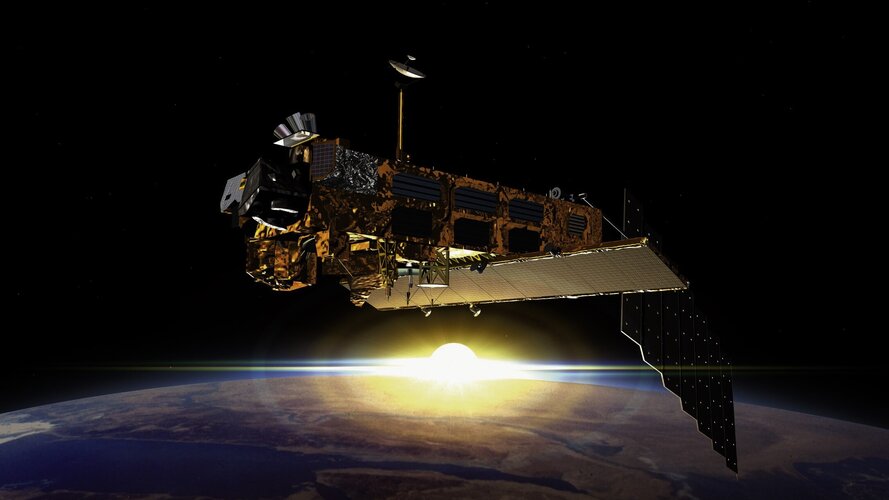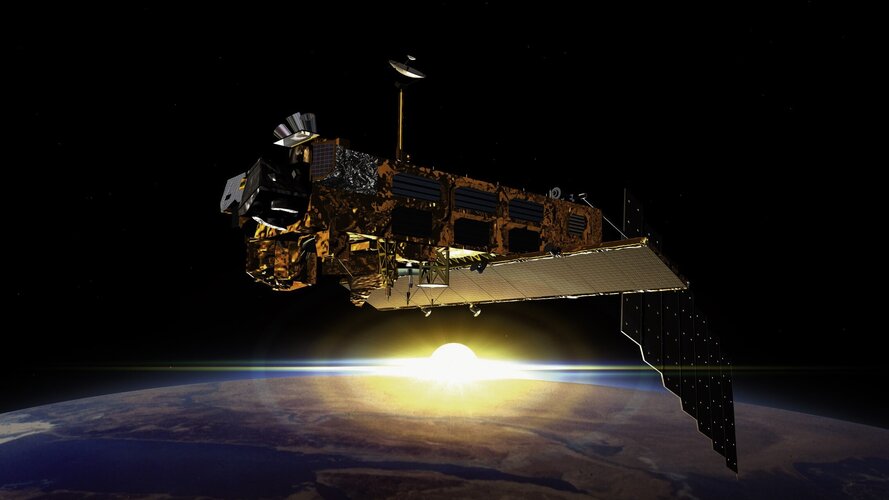ISS operations remain normal ahead of private astronaut mission
Tuesday, 01 March 2022 10:25
NASA said that operations of the International Space Station remain normal despite the growing rift between Russia and the West in response to Russia’s invasion of Ukraine.
The post ISS operations remain normal ahead of private astronaut mission appeared first on SpaceNews.
Rocket Lab launches Electron rocket, selects Virginia for Neutron factory
Tuesday, 01 March 2022 09:17
Rocket Lab carried out its first Electron launch of the year Feb. 28, placing a Japanese radar imaging satellite into orbit at the same time the company released its financial results and selected Virginia for a rocket factory.
North Korea hails 'significant' test in military satellite developments
Tuesday, 01 March 2022 07:36 North Korea said it had carried out a test of "great significance" for developing a reconnaissance satellite, state media reported Monday, a day after Seoul said it had detected a ballistic missile launch.
Despite sweeping international sanctions, Pyongyang carried out a record-breaking blitz of weapons tests in January before pausing launches during the Beijing Winter Olympics.
On Sun
North Korea said it had carried out a test of "great significance" for developing a reconnaissance satellite, state media reported Monday, a day after Seoul said it had detected a ballistic missile launch.
Despite sweeping international sanctions, Pyongyang carried out a record-breaking blitz of weapons tests in January before pausing launches during the Beijing Winter Olympics.
On Sun NASA invites collaboration to define future of air travel
Tuesday, 01 March 2022 07:36 We've long held dreams of what the future of air travel could look like. Something out of the Jetson's TV show or a Star Wars movie is generally the "go to" vision for most people: aircraft of all types and sizes - including those without pilots onboard - safely flying anywhere at all altitudes anytime for many different reasons.
But there's more to it than that. It's a future that could i
We've long held dreams of what the future of air travel could look like. Something out of the Jetson's TV show or a Star Wars movie is generally the "go to" vision for most people: aircraft of all types and sizes - including those without pilots onboard - safely flying anywhere at all altitudes anytime for many different reasons.
But there's more to it than that. It's a future that could i Envisat 20-year anniversary
Tuesday, 01 March 2022 07:30 Video:
00:04:00
Video:
00:04:00
Twenty years ago, on the first of March 2002, ESA launched a new satellite to monitor our planet from space: Envisat. This research mission, which carried 10 instruments, would become a beacon for the development of future Earth observation satellites. In orbit for 10 years, double its projected lifespan, this flagship mission provided science with a wealth of data on the health of our planet and climate change – a treasure trove of data that is still used today. Thanks to the Heritage Space Programme, ESA ensures these precious data are preserved and made accessible for
Envisat: 20 years after launch
Tuesday, 01 March 2022 07:30 Video:
00:04:00
Video:
00:04:00
Twenty years ago, on the first of March 2002, ESA launched a new satellite to monitor our planet from space: Envisat. This research mission, which carried 10 instruments, would become a beacon for the development of future Earth observation satellites. In orbit for 10 years, double its projected lifespan, this flagship mission provided science with a wealth of data on the health of our planet and climate change – a treasure trove of data that is still used today. Thanks to the Heritage Space Programme, ESA ensures these precious data are preserved and made accessible for
NASA awards SpaceX additional crew flights to Space Station
Tuesday, 01 March 2022 06:00 NASA has awarded three additional missions to Space Exploration Technologies Corporation (SpaceX) of Hawthorne, California, for crew transportation services to the International Space Station as part of its Commercial Crew Transportation Capability (CCtCap) contract.
The CCtCap modification, following the agency's notice of intent to procure the flights in December 2021, brings the total m
NASA has awarded three additional missions to Space Exploration Technologies Corporation (SpaceX) of Hawthorne, California, for crew transportation services to the International Space Station as part of its Commercial Crew Transportation Capability (CCtCap) contract.
The CCtCap modification, following the agency's notice of intent to procure the flights in December 2021, brings the total m Rocket Lab selects Virginia for Neutron launch pad and manufacturing complex
Tuesday, 01 March 2022 06:00 Rocket Lab USA, Inc (Nasdaq: RKLB) has selected Wallops Island, Virginia, as the location for its first launch site and extensive manufacturing and operations facilities, for its 8-ton payload class reusable Neutron rocket.
The Neutron Production Complex and launch pad for its Neutron rocket will be located adjacent to and within the NASA Wallops Flight Facility and Mid-Atlantic Regional S
Rocket Lab USA, Inc (Nasdaq: RKLB) has selected Wallops Island, Virginia, as the location for its first launch site and extensive manufacturing and operations facilities, for its 8-ton payload class reusable Neutron rocket.
The Neutron Production Complex and launch pad for its Neutron rocket will be located adjacent to and within the NASA Wallops Flight Facility and Mid-Atlantic Regional S New rocket to be partially reusable
Tuesday, 01 March 2022 06:00 China's next-generation rocket designed to carry astronauts will be multifunctional and partly reusable, according to a senior rocket scientist.
Wang Xiaojun, president of the China Academy of Launch Vehicle Technology, the country's major maker of carrier rockets, told an international forum in mid-February that the new rocket, which has yet to be named, will have two models.
The fi
China's next-generation rocket designed to carry astronauts will be multifunctional and partly reusable, according to a senior rocket scientist.
Wang Xiaojun, president of the China Academy of Launch Vehicle Technology, the country's major maker of carrier rockets, told an international forum in mid-February that the new rocket, which has yet to be named, will have two models.
The fi First Multiple-Sol Drive
Tuesday, 01 March 2022 06:00 Perseverance capped its first year on Mars by speeding back around Seitah toward what is expected to be the final sampling location in its crater floor campaign. The drive on Mars was split across three different sols executing instructions planned in a single day on Earth, making this Perseverance's first multiple-sol drive.
Why are we excited about the multiple-sol drive? It creates an o
Perseverance capped its first year on Mars by speeding back around Seitah toward what is expected to be the final sampling location in its crater floor campaign. The drive on Mars was split across three different sols executing instructions planned in a single day on Earth, making this Perseverance's first multiple-sol drive.
Why are we excited about the multiple-sol drive? It creates an o Sols 3398-3400: The Road Ahead
Tuesday, 01 March 2022 06:00 The drive on Sol 3397 went well and gave us some good perspective on the road ahead, as seen in the above Navcam image. Curiosity is perched at the edge of the pediment, carefully planning our route to climb fully on top of the pediment capping unit, and the team is eager to investigate these rocks!
This 3-sol plan was a typical weekend plan, with opportunities for contact science, remote
The drive on Sol 3397 went well and gave us some good perspective on the road ahead, as seen in the above Navcam image. Curiosity is perched at the edge of the pediment, carefully planning our route to climb fully on top of the pediment capping unit, and the team is eager to investigate these rocks!
This 3-sol plan was a typical weekend plan, with opportunities for contact science, remote Canberra well placed to play a role in global asteroid detection
Tuesday, 01 March 2022 06:00 A UNSW researcher says we can improve our ability to detect dangerous asteroids from the Southern Hemisphere.
NASA's Near-Earth Object Observation Program painstakingly documents all asteroid sightings that could pose a potential threat to our planet. However, geographical constraints mean that somewhere between 2 per cent and 7 per cent of asteroids are not detected.
Former director
A UNSW researcher says we can improve our ability to detect dangerous asteroids from the Southern Hemisphere.
NASA's Near-Earth Object Observation Program painstakingly documents all asteroid sightings that could pose a potential threat to our planet. However, geographical constraints mean that somewhere between 2 per cent and 7 per cent of asteroids are not detected.
Former director Kilonova afterglow potentially spotted for first time
Tuesday, 01 March 2022 06:00 For the first time, Northwestern University-led astronomers may have detected an afterglow from a kilonova.
A kilonova occurs when two neutron stars - some of the densest objects in the universe - merge to create a blast 1,000 times brighter than a classical nova. In this case, a narrow, off-axis jet of high-energy particles accompanied the merger event, dubbed GW170817. Three-and-a-half y
For the first time, Northwestern University-led astronomers may have detected an afterglow from a kilonova.
A kilonova occurs when two neutron stars - some of the densest objects in the universe - merge to create a blast 1,000 times brighter than a classical nova. In this case, a narrow, off-axis jet of high-energy particles accompanied the merger event, dubbed GW170817. Three-and-a-half y China eyes Qinghai-Tibet Plateau site for new radio astronomy observatory
Tuesday, 01 March 2022 06:00 Chinese astronomers plan to build a new submillimeter-wave observatory on the Qinghai-Tibet Plateau, known as "the roof of the world."
Proposed by the Nanjing-based Purple Mountain Observatory of the Chinese Academy of Sciences, the observatory project includes a new submillimeter-wave telescope with a diameter of 15 meters, larger than China's current most advanced 13.7-meter radio telesc
Chinese astronomers plan to build a new submillimeter-wave observatory on the Qinghai-Tibet Plateau, known as "the roof of the world."
Proposed by the Nanjing-based Purple Mountain Observatory of the Chinese Academy of Sciences, the observatory project includes a new submillimeter-wave telescope with a diameter of 15 meters, larger than China's current most advanced 13.7-meter radio telesc Intelsat teams with Microsoft to demonstrate private cellular network
Tuesday, 01 March 2022 06:00 Intelsat, operator of one of the world's largest and most advanced integrated satellite and terrestrial networks, has announced the successful demonstration of a first of its kind private cellular network with Microsoft Azure Private Multi-Access Edge Compute and FlexEnterprise, Intelsat's satellite-based global connectivity service.
Held at Intelsat's office in McLean, VA, the demonstrati
Intelsat, operator of one of the world's largest and most advanced integrated satellite and terrestrial networks, has announced the successful demonstration of a first of its kind private cellular network with Microsoft Azure Private Multi-Access Edge Compute and FlexEnterprise, Intelsat's satellite-based global connectivity service.
Held at Intelsat's office in McLean, VA, the demonstrati 
